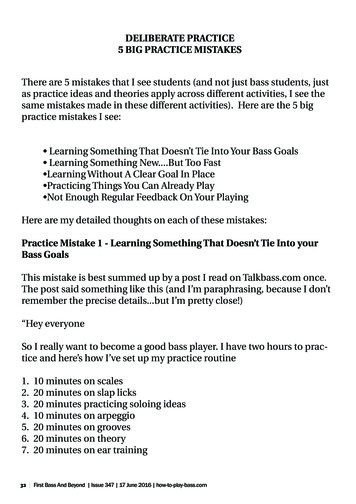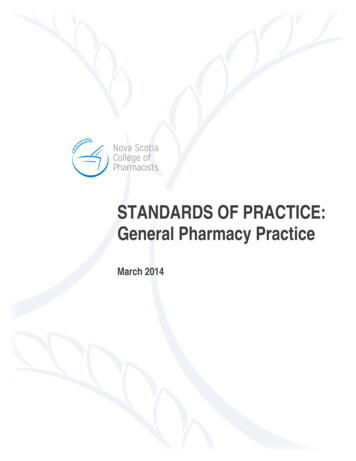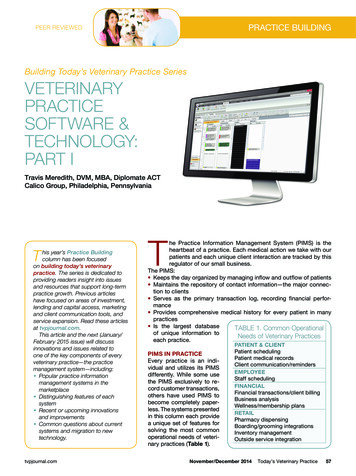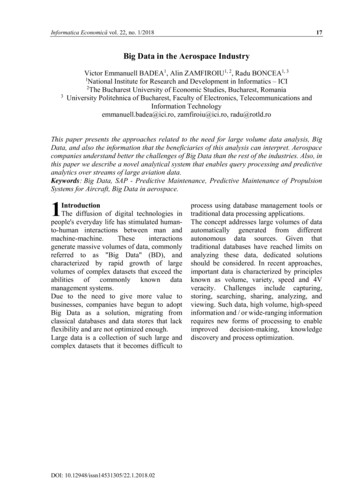
Transcription
DELIBERATE PRACTICE5 BIG PRACTICE MISTAKESThere are 5 mistakes that I see students (and not just bass students, justas practice ideas and theories apply across different activities, I see thesame mistakes made in these different activities). Here are the 5 bigpractice mistakes I see: Learning Something That Doesn’t Tie Into Your Bass Goals Learning Something New.But Too Fast Learning Without A Clear Goal In Place Practicing Things You Can Already Play Not Enough Regular Feedback On Your PlayingHere are my detailed thoughts on each of these mistakes:Practice Mistake 1 - Learning Something That Doesn’t Tie Into yourBass GoalsThis mistake is best summed up by a post I read on Talkbass.com once.The post said something like this (and I’m paraphrasing, because I don’tremember the precise details.but I’m pretty close!)“Hey everyoneSo I really want to become a good bass player. I have two hours to practice and here’s how I’ve set up my practice routine1.2.3.4.5.6.7.10 minutes on scales20 minutes on slap licks20 minutes practicing soloing ideas10 minutes on arpeggio20 minutes on grooves20 minutes on theory20 minutes on ear training32 First Bass And Beyond Issue 347 17 June 2016 how-to-play-bass.com
What have I missed out?”Now for my own reasons I don’t post in Talkbass.com very often, so Ididn’t leave any “feedback” for this guy. If I had, it would have beenalong these lines:“Hey manI applaud your intentions. However your execution is poor. Here’s why:you are missing crucial steps in the process of improving as a bass player.The biggest step you are missing is having a clear goal of the level youwish to attain. Without having a concrete picture of where you want toget to, how can you be sure that your practice time is invested in movingyou closer to that goal.Let me give you an example: say you had to drive a 57 Mustang fromCentral Park, New York to the Golden Gate Bridge in San Francisco for abet. Which of the two options below do you think would get you to yourdestination in the most efficeint manner:1. Pick up the Mustang. Trust that you vaguely know which way is west.And start driving.2. Pre-plan your route taking into account driving times, rest stops,overnight stops, refuelling, and so on. Progam said route into your GPS.Pick up the Mustang. Start following your pre-planned route. FollowCourse Corrections suggested by your GPS any time you make an unintended deviation.Of course the answer is Option #2.It’s a no-brainer, right?Let’s go back to your bass practice. Without defining what becoming ‘agood player’ means to you it’s impossible to tell whether the practice33 First Bass And Beyond Issue 347 17 June 2016 how-to-play-bass.com
you are doing is moving you closer to that goal.Let me give you a practical example: if you define ‘a good bass player’ assomeone who can play walking bass lines and solo in a mainstream jazzcontext then the kind of things they should be practicing are totally different to a person who wants to become a ‘good bass player’ but definesit as being able to play staccato 16th note funk like Rocco Prestia.Does that make more sense?Knowing where you want to get to not only allows you to focus with laser precision on what you should be practicing, it also makes it a gazillion times easier to know when you’ve drifted off course - and how to getback on course - and how to track your progress.So the very first thing you need to define is: where are you going to as abass player?”Now this might sound basic. But you’d be surprised at how many bassplayers I see with detailed practicing schedules who have no concreteidea of what they are trying to achieve.My advice is to spend an hour writing down what you’re trying toachieve on the bass and where you want to get to. And be as concrete asyou can - list tunes you want to be able to play, or bass players you likeand what elements of their style you want to be able to emulate and soon.When you’ve got that clear picture in your head, or preferably writtendown on a piece of paper, then - and only then! - go to your practiceactivities and audit them based on your goals. Ask this question of everything you practice:“Will practicing this move me towards my bass playing goals?”If the answer is no, then strike it from your practice list and replace itwith something that does.34 First Bass And Beyond Issue 347 17 June 2016 how-to-play-bass.com
Practice Mistake 2 - Learning Something New But Too FastThere’s a tennis academy near Moscow for women tennis players - Idon’t know the latest stats but in the mid-2000s there were more womenin the World Tennis Top 20 that had trained at this Academy than therewere tennis players from any other country.You’re probably imagining that this Academy - it’s called the SpartakAcademy by the way - is a state of the art training facilty. If you’re thinking that you’d be wrong.this academy has 15 clay courts which due tothe weather are only open for four months in the year, and just two indoor courts for all year use.And yet despite their basic facilities they produce top tennis players.That’s down to the training regime.Every day at Spartak every one of the students - ranging from the youngnewly arrived girls (I think they ‘board’ from Age 7) right through to theolder girls who are preparing to leave and try their luck on the professional tennis circuit - do the same exercise.That exercise is to spend an hour hitting ‘perfect’ shots in slow motionover and over. (There are no tennis balls in this exercise.they are visualized.)There are two really important parts to this exercise:1. The slow motion2. The repetitionThe slow motion allows for correction of any mistakes in weight distribution, angle of racket, position of hand and wrist and arm and shoulderand so on.And the repetition is part of teaching the brain the ‘perfect’ way to playthis shot.35 First Bass And Beyond Issue 347 17 June 2016 how-to-play-bass.com
How This Applies To The BassWhen you’re learning a new piece if you try and learn it too fast, thenyou’ll incorporate mistakes into what you are doing. If you don’t fixthose mistakes your brain will ‘assume’ that you are content with thisand fast repetitions will just solidify these mistakes.That’s why it’s vital to start out with new material playing really slowly.I advise the following approach to learning something new:1. Chunk what you’re learning into manageable parts2. Take the first chunk and play it out of tempo. You’re looking for potential problem areas, or potential areas where you need to examineyour technique.3. When you are happy with where you are going to play every note youcan start playing with some kind of metronomic background. (I use achordal metronome.)But the first playthroughs should be done really slowly.most studentsdefine really slowly as maybe 15 or 20 BPM slower than the original.That’s still too fast. I often learn things at around 50% of the originaltempo initially (often this has the metronome at 50-60 BPM). My goalisn’t to get up to performance speed as quickly as possible it’s to play at aspeed where I can put in a perfect playthough.4. When I’ve done a perfect playthrough I want to start the solidificationof this learning. So I’ll aim for at least 9 more.5. Only then will I increase the speed of the chordal metronome. Andoften I’ll only nudge it by three or four BPMS.five at the most. Andthen aim for another bunch of perfect repetitions.6. By the time you’ve increased tempo three times (so the original tempo plus three incremental increases) you’ve put in 40 perfect repetitions.36 First Bass And Beyond Issue 347 17 June 2016 how-to-play-bass.com
And what you’ve done is the equivalent of programming a circuit in yourbrain that will ‘play that section’ whenever you need it to. Often almostsubconsciously.7. You can keep increasing the tempo slowly. Before you know it you’llhave not only mastered the ‘chunk’ you were working on, but you’ll havelearned it to a level that your brain will remember almost forever.The next time you’re learning a song.take this technique for a spin andsee what happens. I guarantee it will change the way you look at learning new material!Practice Mistake 3 - Learning Without A Clear Goal In PlaceThis practice mistake overlaps practice mistake 1 in some ways. We’vetalked about Practice Mistake 1 already, if you missed that email hit reply and I’ll send it to you. (Actually I should put all these articles somewhere where you can read them not just in your email inbox.I’ll workon that for tomorrow and post some links!)Now Practice Mistake 1 was more about ensuring that you have bassgoals in place and make sure that your practice brings you closer toachieving those goals.That’s like the 10,000 Foot view.Practice Mistake 3 is more like the 100 foot view.How many of you can honestly answer this question: before you pick upyour bass to start practicing on EVERY-SINGLE-DAY that you practiceyou already know 100% what you are going to practice.Let me go deeper into the question: how many of you before you practice have a concrete practice schedule for the day detailing not onlywhat you are going to practice and for how long you are going to practiceit?37 First Bass And Beyond Issue 347 17 June 2016 how-to-play-bass.com
I’m guessing probably not many of you?Why Is This Important?Let me give you an analogy to help you understand this. We’re going touse a commercial airline flight as an analogy.Before we do I just want to give you an interesting fact that you may notknow: did you know that for over 95% of EVERY commercial flight theplane is technically off course?And yet - barring unexpected emergencies and dangerous weather conditions - every flight lands at the desired destination.The reason they can do this is that periodically during the flight the pilot and co-pilot check their current course against where they are going.And it is so common that it is routine to make small and subtle coursecorrections because the plane is slightly off-course due to tailwinds orheadwinds or sidewinds.So tieing this back to bass.If you board a flight at New York’s JFK airport heading for London Heathrow then in bass terms JFK Airport represents where you are now as abass player. And London Heathrow represents where you want to be.To ensure as a bass player you arrive at the bass playing equivalent ofLondon Heathrow you have to work backwards from Heathrow all theway back to JFK (I’ll give you a bass example in a moment) and that creates an overall practice plan.Then you work on practice elements that take you along this journey.There are two reasons you write everything down (and use a timer toclock how much time you practice): (i) to ensure that you are movingforward on your bass playing flight path (ii) so you can take course corrections if you are veering off the path.38 First Bass And Beyond Issue 347 17 June 2016 how-to-play-bass.com
My Bass Playing Flight PathOn Saturday I shared with you my bass playing goal (appended to theend of this article)- which is to emulate James Jamerson’s playing (onefinger on the plucking hand, reliance on first position with the frettinghand) on some of my favourite classics like Bernadette and Standing InThe Shadows and My Whole World Ended and so on.So working backwards from that (and bear in mind that this is just asnap shot of a more detailed document):1. The Destination: Playing Bernadette/Standing In Shadows etc incorporate Jamerson’s playing devices at a 16th note rhythmic level. Activities to practice: common rhythmic patterns, common rhythmic patternsusing common melodic devices, common rhythmic patterns combinedwith rakes and pull-offs and open strings and so on.2. Moving From Straight 8th Note Rhythms to 16th Note RhythmsAround 65/66 Jamerson started building on his straight 8th note patterns with some 16th note rhythmic accents. Tracks like Behind aPainted Smile, Keep Me Hanging On, etc. Activities to practice common‘transition’ rhythmic patterns, practicing these transitional rhythms withmelodic devices, with open strings, and so on.3. Straight 8th Note Rhythms Around 64 to 65 Motown started moving away from the shuffle rhythm that dominated their sound in theearly Motown period. Tunes include songs like Back In My Arms Again,This Old Heart Of Mine, Get Ready, Going To A Go-go, Uptight, Ain’t NoMountain High Enough, and so on. practice activities include the identification of 8th note rhythms that Jamerson used, and identification ofwhich melodic devices he was using at this stage of his career and modelling both.4. Early Shuffle Tunes Motown’s first big sellers were shuffle basedtunes - Heatwave, Baby Love, Where DId Our Love Go etc. Even withinrelatively simple tunes we get glimpses of some of the things Jamersonwas going to do.identify and practice etc etc.39 First Bass And Beyond Issue 347 17 June 2016 how-to-play-bass.com
As I Said This Is A Snapshot.AND A Working DocumentEach of these stages is broken down into more sub-stages. And becauseit’s a living, breathing plan it gets altered (a course correction) with nearly every week of practice.The point is.and the big takeaway from the article.is if you are clearabout where you want to get to as a bass player you can start moving inthat direction once you’ve spent some time thinking about where thatdestination is and how you might get there.When you have such clarity to your goals it’s much easier to be alwaysmoving towards them than if you think: Yep, I wanna be a better player.I’m gonna go learn this great funk riff I saw on YouTube today.Said riff might sound cool but before you start learning it and investing valuable practice time ask yourself this question: does learning thismove me towards my goals? If the answer to that question is no.then Ihighly recommend reconsidering whether to invest practice time on it.Practice Mistake 4 - Practicing Things You Can Already PlayThis
20 minutes on slap licks 3. 20 minutes practicing soloing ideas 4. 10 minutes on arpeggio 5. 20 minutes on grooves 6. 20 minutes on theory 7. 20 minutes on ear training. 33 First Bass And Beyond Issue 347 17 June 2016 how-to-play-bass.com What have I missed out?” Now for my own reasons I don’t post in Talkbass.com very often, so I didn’t leave any “feedback” for this guy. If .











